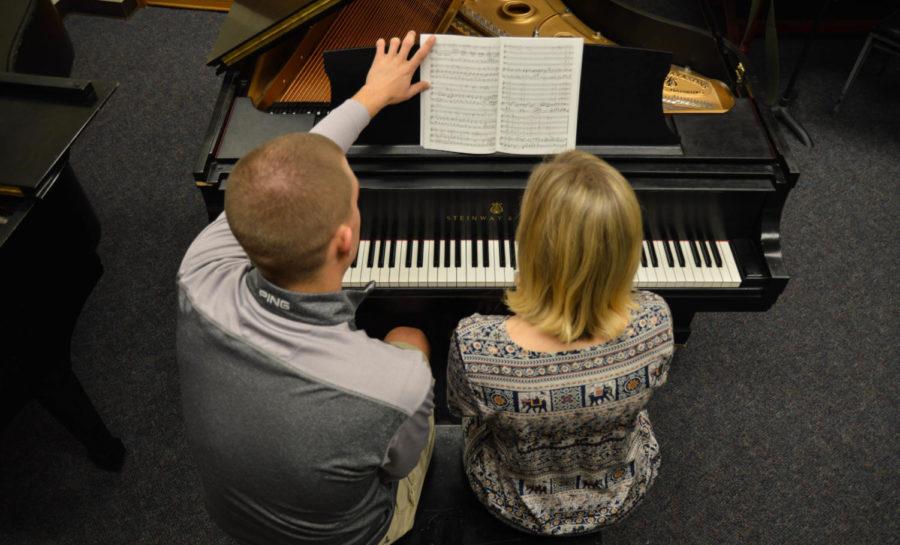A high price: The treble for music majors
Maddie Leopardo/Iowa State Daily
Senior Grant Luther and junior Jenna Sandquist are both music majors with an emphasis on vocals.
March 19, 2017
Driving down the streets of campus, junior Peter Bekkerus knows that the euphonium stashed away in his trunk is worth more than the entire car itself. It also acts as his pen and paper, the key to a future in performance art.
He is one of many students enrolled in the Iowa State music department, a curriculum that can be forgotten under the umbrella of the university’s focus on technology and agriculture.
But for many of these students, earning a music degree isn’t as simple as playing notes correctly. It involves dedication beyond the classroom, which can culminate in large sums of money and even larger quantities of stress.
Though students must still be accepted into Iowa State individually, the music program remains unique, as it is one of several colleges to handpick students into their respective programs.
This process begins with an initial audition pertaining to either a specific instrument or vocal performance. Professors who lead audition-only studios then choose who they would like to accept into their space of practice. Only so many spots are open at any given time, so students who are not selected must wait another year until they are permitted to audition again.
“Vocal performance is one of our most competitive studios,” bassoonist instructor and music adviser Kevin Judge said. “We have three professors, and they have to turn away about half of the applicants every year. Those who audition are categorized under liberal arts and sciences, which means you’ll either audition and get accepted or become open option.”
Due to deeply-rooted passions, the audition process was a stressful period for hopeful music majors, not because of the time commitment but rather for the idea of rejection.
“The selection process is why I applied to five different schools, because I didn’t want to stay in state,” said Rhett Allen, junior in communication studies with a minor in music. “It became a question of where can I get the most scholarships.”
The importance of scholarships becomes clear when considering the cost of individual instruments for students. Financial aid is available to help pay for the purchasing of music equipment, however, students must prove their need for an instrument in order to reduce cases of equipment purchases outside the program.
“I remember filling out a financial aid recommendation form for a student buying a flute that was $10,000,” Judge said. “There’s a range of prices, starting with trumpets that you could play in the Chicago Symphony running for about $2,000 to $3,000. However, if you look at violinists, I would think they could pay closer to $20,000 to $30,000 for a single instrument.”
Olympia Manning, junior in violin performance, wasn’t initially aware of the large costs associated with her instrument until the end of high school.
Beginning with a $1,000 model violin, Manning soon upgraded to a model that cost $2,100. Due to having played several different instruments, she soon realized her choice was among the most expensive.
“I didn’t really know how expensive a violin could get until I played clarinet and I saw that it was much cheaper,” Manning said. “But they can get much more expensive. A Stradivarius model can be upward of $3 million.”
Though expensive, Bekkerus sees the purchasing of instruments as a necessity that cannot have shortcuts.
“You learn early that you either have to put up or stop trying,” Bekkerus said. “The instrument in the trunk of my car is worth more than the car itself.”
Besides the financial pressures, time management is one the most important skills a music major can possess within the program behind musical talent, Judge said.
Students within the program are required to attend a certain number of music concerts per semester and learn piano proficiency, as well as take part in evaluation tests their sophomore year to determine if they can remain a music major.
“They say Cs get degrees, but that isn’t true here,” Bekkerus said. “You’re expected to practice and know your part. Most of the classes have a grading scale that states anything below an A is considered failing.”
Bekkerus currently takes 21 credit hours and is involved in several ensembles and music-related clubs such as pep band and a brass quartet.
Allen said the Iowa State music program is dominated by many one-credit classes such as choir, meaning four to five classes for an engineering major may equate to seven or eight for a music major. For Allen, this means more time is taken away from other classes and activities not associated with music.
“Those one-credit courses may only be an ensemble or choir but there’s so many hours outside of class that you have to practice,” Allen said. “Not only that but you have to go to practices, trips with groups and more. It gets to be stressful.”
Despite the full load, Judge remains confident that most of the students who walk onto the Iowa State campus are ready and capable of facing the challenge.
“We’re lucky that many of our students are very bright and come to Iowa State with that creative gene and high ACT scores,” Judge said. “This generally equals good time management. I tell them you’ll be busy from 8 a.m. until the end of class, but you won’t have much outside work like typical tests or worksheets. This is because academic professors realize there’s ensembles that are going to take place.”
Judge still sees that most students remain happy throughout the process pursuing what they love to do.
“They keep busy on the weekends, mostly with concerts, so it’s a lot, but I think they enjoy it,” Judge said.







